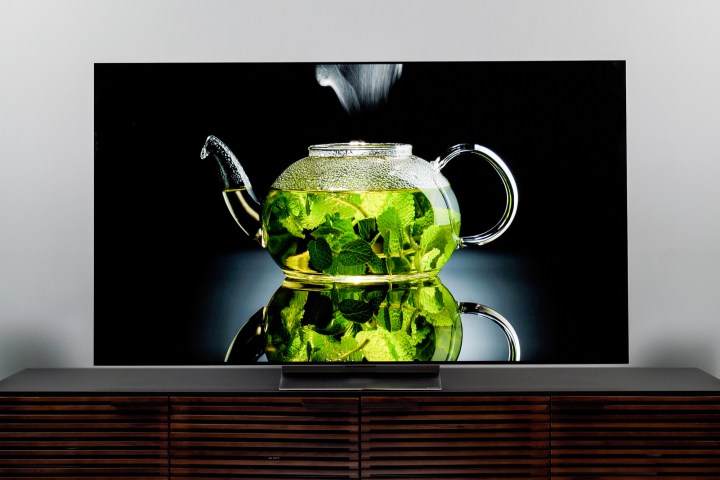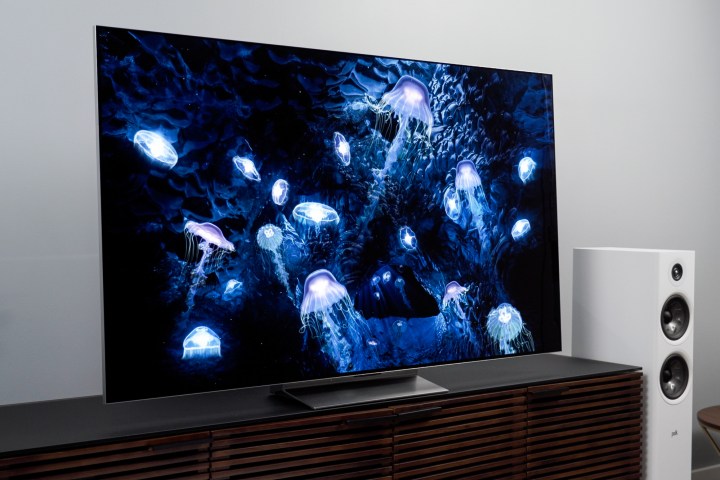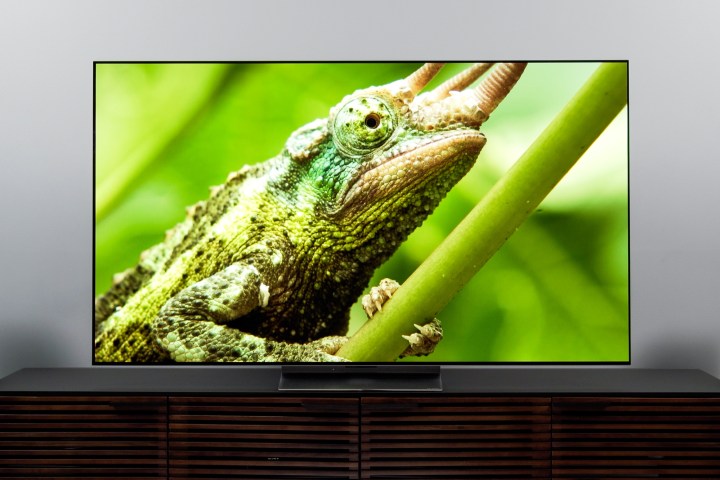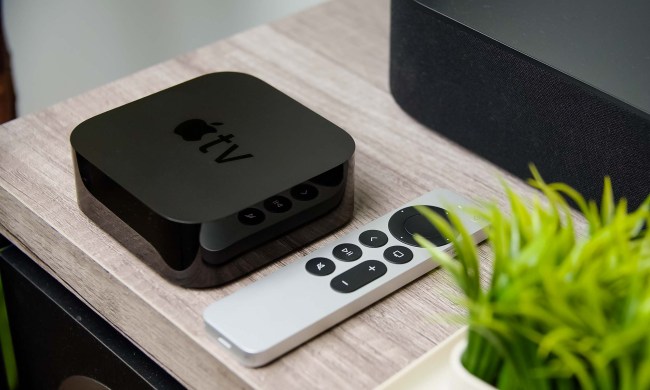
- Class-leading brightness
- Outstanding color accuracy
- Perfect black levels
- Top choice for gamers
- Top-notch design
- Disappointing stand-mount option
The problem with reviewing TVs is that sometimes you get one that’s so deeply enjoyable to watch that you kind of, you know, forget that you’re supposed to be working and end up just watching TV for a bunch of hours. That’s what happened to me with the LG G2 OLED Evo TV. Perhaps not my most productive work moment, but I think it says a lot about this TV.
Part of LG’s Gallery Series, The G2 OLED Evo is the best 4K OLED TV LG has made to date. It’s in contention for the
While the LG G2’s picture quality is certainly stunning, it may not be the right TV for you. In this review, I’m going to cover what’s good, great, and even stupendous about the LG G2 OLED TV. (And let’s not get it confused with the old LG G2 Android phone; this most certainly is not that.) But I’m also going to dig into the reasons it may not be the best candidate for everyone. In the end, I hope you’ll know whether it might be right for your home entertainment.
Video review
LG G2 Series details
While we reviewed the 65-inch G2 model, our review also applies to the 55-inch, 75-inch and 83-inch models.
| Screen Size | Model Number | MSRP |
| 55-inch | OLED55G2PUA | |
| 65-inch | OLED65G2PUA | |
| 75-inch | OLED77G2PUA | |
| 83-inch | OLED83G2PUA |
The LG G2 OLED is loaded to the hilt
The list of the LG G2’s admirable attributes is long. It’s got four HDMI 2.1 inputs, it looks stunning mounted on the wall with the no-gap wall mount that’s included in the box, and it is indeed LG’s brightest OLED TV to date thanks to LG’s OLED EVO technology — a blend of hardware and software efforts that, in the case of the G2, happens to include a heat sink in the panel that allows the TV to reach high brightness levels while also reducing the risk of permanent image retention — burn-in.
If the idea is to deliver on creative intent, then LG is very much standing toe-to-toe with Sony
As an OLED TV, the LG G2 offers pitch-black black levels, setting the foundation for eye-popping contrast. LG’s processing has gotten very strong lately, which makes for solid motion performance, minimal noise and artifacts, and very smart use of its peak brightness capabilities. In other words, the G2 doesn’t just get bright for brightness’ sake — although you can force it to do so. However, in its most accurate picture preset modes, it resolves bright highlight detail in a way that is reminiscent of Sony’s TVs.
If the idea is to deliver on creative intent, then LG is very much standing toe-to-toe with Sony in that regard, even if that isn’t one of the G2’s primary marketing lines.
As far as bells and whistles go, the G2 is loaded with them. Voice control, automatic source detection, smart-home integration, and more gamer-friendly features than any other brand, including Nvidia G-Sync, AMD Free-sync, and generic Variable Refresh Rate support which, along with those four HDMI 2.1 inputs, low input lag, and a gaming dashboard, culminates in a highly attractive list of features for gamers who want it all, even if they aren’t likely to use it all.
My only real complaint about this TV is its stand-mount option. The stand is something you purchase separately since LG intends for this TV to be mounted on the wall (hence the inclusion of said wall mount in the box). However, I don’t like how the stand fits, feels, or works. I’m not a fan of the steep, raked back angle in which it positions the TV, either.

If asked, I think LG might go so far as to suggest that if you want a stand-mounted TV, then its less expensive C2 model would be a better option. My problem with that philosophy is that the G2 is a brighter, higher-performance TV, so someone may want it for more than just its inherently slick wall-mount design.
There’s one other factor that might count as a negative for some people, but I’m going to get to that in a moment.
Performance by the numbers
For my measurements, I more or less stuck to the typically accurate “Filmmaker Mode” for SDR and
In Filmmaker Mode for SDR, peak luminance registered at 170 nits. To be clear, the TV can get much higher than that if you set it to. But remember that Filmmaker mode is supposed to make the picture “accurate” and caps SDR brightness at the established standard. If one were to go into the “Expert” picture mode and set the peak brightness option to high and the OLED Light setting to the max, one could enjoy up to 450 nits of practical brightness, which is both impressive for an OLED TV and good enough to do battle with a daylight-filled viewing environment.

Peak brightness measurements in
Brighter whites. But brighter colors?
The real advantage to the QD-OLED technology that we see in the Samsung S95B and Sony A95K over the WRGB OLED tech used in the LG G2 here is in the color brightness. If we measure six key colors — red, green, blue, yellow, magenta, and cyan, what we find is that the LG G2 comes in shy of QD-OLED by anywhere from one-half to one-third as bright — the most notable differences being in how bright red, yellow, and green can get.
I’m going to stop there with the comparisons to QD-OLED because I’m saving that for my QD-OLED vs. OLED comparison piece, but it’s important to bring up because we can’t just call the G2 the brightest OLED ever — brightest in some ways, yes, but not in others.
Folks, this TV is drop-dead gorgeous to behold.
With that said, the LG G2 measured impeccably across the board. Using Calman Calibration software and a C6 colorimeter profiled to an Xrite i1Pro 2, I found that right out of the box in Filmmaker mode this unit was already dangerously close to offering accurate D65 white point. I was able to get it just a bit closer to nirvana with a little tweaking in SDR and
So, the TV measures extremely well — one of LG’s best-measured TVs, if not the best. Does it watch equally as well?
Oh, man. Yes. Yes, it does.
Forget the numbers, trust your eyes
Folks, this TV is drop-dead gorgeous to behold. Full stop. That’s why I got distracted and just ended up re-watching movies I’ve already seen, like, 10 times. It was fun to watch them again on the G2 because the picture quality is just so fun and enjoyable. It’s really a spectacle, and I enjoyed almost every minute of it.

As an OLED TV that has a nearly instantaneous pixel response time, you will see a bit of stutter — a kind of a flashing effect — during slow pans in 24 fps film content — that’s just how it is if you don’t enable motion the TV’s motion smoothing option. But other than that, I just spent my entire time with this TV gushing to myself over the deep, rich picture quality. At no time did I spend any time thinking the color brightness could have been higher. Now, that’s probably because I have limited hours watching QD-OLED TVs at this point, but without that frame of reference, this TV is simply dazzling. Nobody is going to bring this TV home and feel like they want more.
Unless — and here’s the big BUT — unless you watch in a fairly bright room.
But is it a good bright-room TV?
It pains me to say this because I have not been one to harp on OLED as being a poor bright-room TV in the past. And here we are with the G2, an extremely bright OLED TV, so you’d think I would be reluctant to cast any doubts around whether or not you’d be anything short of thrilled with this TV. But, I had an interesting conversation the other day that lends a little perspective.
Though it’s not really my style to name-drop, I’m going to anyway: I was talking to YouTube sensation Jon Rettinger recently about his next TV purchase. Jon, who reviews plenty of TVs himself, currently has the vaunted Sony Z9D, and he’s looking to replace it. He doesn’t want to buy another TV for at least five more years, so he wants to get this purchase right, and he’s been waffling between an OLED TV or a mini-LED QLED TV.
There can be some advantages to going with a mini-LED backlit QLED TV with just astonishing brightness horsepower.
We got to talking about the LG G2 and after singing the G2’s praises as I’ve just done here, and going back and forth a little, I think Jon was a little surprised that I ended up suggesting he consider some other options. Once I learned about where Jon’s TV is going to go, when they watch TV, where the windows are in his space, whether they are down to close the blinds every time they watch TV, how often his family watches this TV, and where the lighting is placed in his room — I ultimately figured that the G2 might not be the right option for his specific situation.
Of course, Jon ended up getting the G2 anyway, and last I heard, he’s thrilled about the decision. But, the process of vetting Jon’s specific needs and viewing environment reminded me that while I think the G2 is going to be an amazing option for a huge slice of buyers out there — I can’t say enough great things about it — in certain scenarios, I think the move to mini-LED might be the smarter call for some who will most often watch their TV in a room flooded with daylight. That isn’t to say the G2 remains a dark-room-only TV, but there can be some advantages to going with a mini-LED backlit QLED TV with just astonishing brightness horsepower.

With that caveat out of the way, I want to be clear that the LG G2 is an absolutely remarkable, jaw-droppingly gorgeous TV to behold, and it earns every cent of its asking price. For those looking for a premium home entertainment experience, the LG G2 OLED Evo TV is one of the best options on the market today.
Our take
Is there a better alternative?
The LG G2 shares rarified air with just a handful of other premium, flagship TVs, none of which could be considered objectively superior in all categories of consideration. The Sony A95K is an equally astonishing TV, but it is considerably more expensive, and not as bright on average. The Samsung S95B is also a strong challenger in the same price range, but not as bright on average. The Samsung QN95B is similarly priced, very competitive in terms of overall picture quality, and brighter in all measurable ways, but try as it may, it still can’t beat OLED and the perfect blacks and screen uniformity game.
How long will it last?
Given its premium construction, highly advanced technical prowess, and update ability, the LG G2 will last well into the future and is not likely to be eclipsed by newcomers any time soon.
Should you buy it?
Yes. The LG G2 is a remarkable TV and were it not for its disappointing stand-mount option, would likely have earned a perfect 10 score. For those who are wall-mounting, don’t hesitate for a moment to purchase this outstanding TV.




